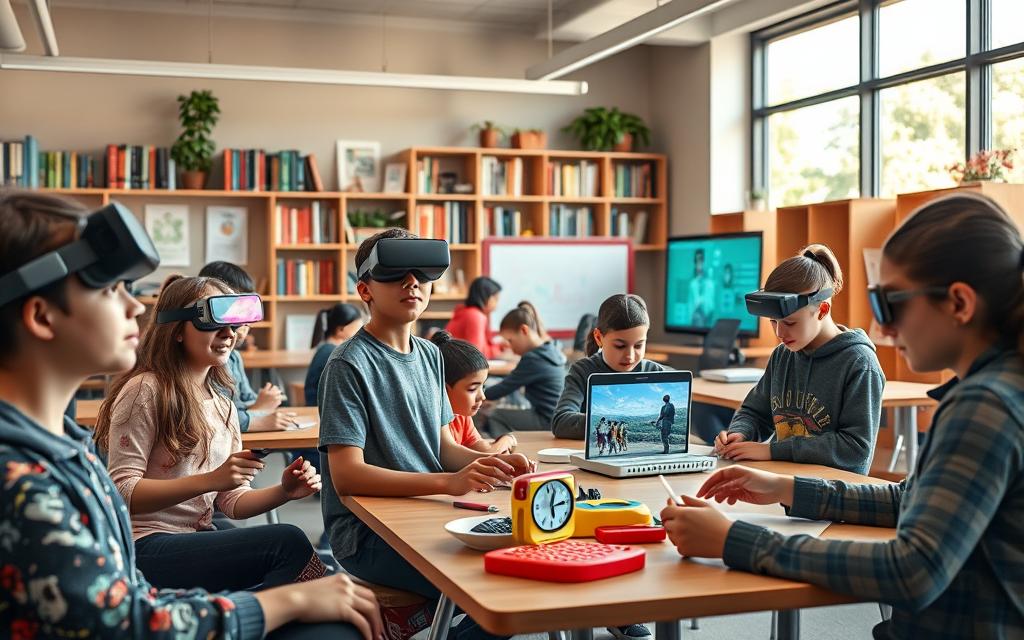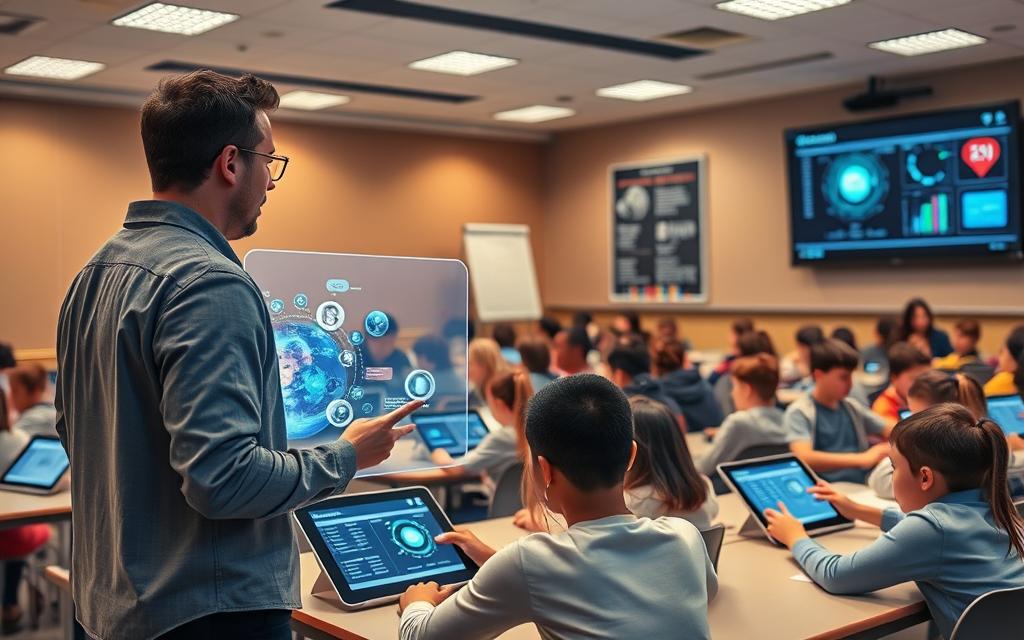Did you know over 90% of educators think AI will change learning and teaching soon? This shows how fast AI is becoming key in our schools. AI helps by making learning personal for students and giving teachers new tools to improve their classes.
We’re going to look at how AI is making classrooms better. We will see its uses, its growing role, and what it means for teachers and students. AI is making education more custom, effective, and easy to get to through things like smart learning platforms and AI-based tests.
Introduction to AI in Education
Artificial Intelligence (AI) is changing the way teachers teach and how students learn. This tech uses algorithms to make some education tasks automatic. More importantly, it helps create a learning space that’s right for each student.
What is AI and How Does It Work?
AI includes technologies that let computers do things that seem intelligent. These things can be analyzing information, finding patterns, and making choices. In schools, AI systems use student data to make teaching better. They adjust learning materials and tests. This makes it easier for teachers to use different ways of teaching that fit each student.
Brief History of AI in Education
The AI education story started with basic computer programs. But, it has grown a lot since then. At first, there were simple systems that didn’t do much. Now, there are smart algorithms and learning models. These offer instant help and know how to react. Schools are getting more into AI to help students learn in new ways.
Current Trends in Educational Technology
Now, AI in U.S. classrooms is becoming more common. Schools are using AI tools that learn from data to help each student in a special way. These tools look at how students act and how well they do in class. Then, teachers can help students learn in their own style. This lets students have a learning experience that’s just for them.
| Trend | Description | Impact |
|---|---|---|
| Adaptive Learning | Use of AI to tailor lessons based on student performance | Improved engagement and mastery of subjects |
| AI-Driven Assessments | Automated scoring and feedback mechanisms | Faster assessment turnaround and personalized insights |
| Data-Enhanced Learning Pathways | Utilizing data analytics to inform instructional strategies | Targeted support and intervention for students |
Enhancing Personalized Learning Experiences
AI has changed how we personalize learning in schools lately. It lets teachers tailor their teaching to each student’s needs. This part talks about how AI helps create unique learning journeys for everyone.
Adaptive Learning Platforms
Adaptive learning uses smart tech to constantly update student lessons. It figures out what each student is good at and what they struggle with. This helps teachers give each student a learning path that’s just for them.
AI-Driven Assessments
AI assessments give instant updates on how students are doing. They show what needs to get better right away. This feedback encourages students to work on their weak spots and grow.
Tailored Curriculum Development
Personalized learning gets even better with customized curriculums. Teachers use data on what students like and how they learn best. This makes learning more fun and effective because it fits each student’s interests.
AI Tools for Teachers and Educators
Classrooms are using more technology, making AI tools vital for teachers. These tools help with tasks, giving educators more time to teach. They allow teachers to focus on teaching instead of admin work.
Virtual Teaching Assistants
AI creates virtual assistants that help teachers. They schedule, answer questions, and lead discussions. This means teachers can spend more time with their students.
Grading Software
Grading software changes how teachers assess work. It gives fast feedback to students, helping them learn. Teachers then have more time for lesson planning and one-on-one instruction.
Lesson Planning and Resource Allocation
AI also helps with lesson planning. It suggests resources based on how students perform. Teachers can make learning better suited to each student’s needs. They can prepare more effectively and improve classroom learning.
Transforming Student Engagement and Motivation
AI is changing education by making learning more engaging and motivating. It uses exciting methods like gamification and interactive lessons. These strategies help learners participate more and make learning fun. This leads to better grades.
Gamification in Learning
Gamification makes learning like playing games. It makes school fun by using points, badges, and leaderboards. This makes students want to do better because they enjoy the competition. It creates a place where students are excited to learn.
Interactive AI-Enhanced Lessons
AI helps make lessons that change for each student. This means lessons get harder or easier depending on how the student is doing. Students find this more interesting and understand better. AI opens up new ways to make sure every student can succeed.
| Method | Description | Impact on Student Engagement |
|---|---|---|
| Gamification | Incorporates game elements in learning. | Boosts motivation and participation. |
| AI-Enhanced Lessons | Adapts content based on student progress. | Increases interaction and understanding. |
Supporting Diverse Learning Styles
AI is changing education by meeting different students’ needs. It helps those who learn differently. Teachers use AI to reach every student, making learning better for them.
AI for Special Education
In special ed, AI tools are very important. They give personalized help, which is great for students with challenges. For example, voice recognition helps students with speech issues use digital content better.
This lets them learn at their own pace and be more independent.
Language Learning Assistance
AI makes learning new languages easier. With AI, students can work on speaking, listening, and writing. It fits their learning style.
AI adjusts to how well they know the language, giving the right exercises. This helps everyone learn better, thanks to AI in education.

Data-Driven Insights for Better Decision Making
In today’s fast-changing educational world, using data wisely is key. It helps create strategies that really work and boost student achievement. Schools use AI to dig into a lot of data and understand how students are doing. This helps make choices that truly help students.
Analyzing Academic Performance
Educators now have AI tools to look closely at how students are doing. They can see which students need more help by looking at their data. This is great because it shows what areas need more work. It also helps teachers adjust how they teach so all students can do better.
Predictive Analytics for Student Success
Predictive analytics is amazing for predicting how students will do. It looks at past and current data. Teachers can see who might start having trouble. This way, they can help these students early. It’s all about making sure every student has the support they need to succeed.
Challenges and Limitations of AI in Education
Integrating AI into education opens many doors but also faces tough hurdles. It’s key to know these issues to use AI wisely in schools. A big worry is how to keep student information safe. With more data being collected, it’s critical to protect it to gain everyone’s trust.
Data Privacy Concerns
Gathering lots of student data brings up concerns about its security and use. Schools need to focus on strong data protection. This helps avoid problems like data breaches. It’s important for schools to follow laws and best practices to keep data safe. Ignoring data privacy can shake trust and cause legal issues.
Equity Issues in Access to Technology
Not all students have the same access to tech, which is a big problem. Those from less wealthy areas may find it hard to use AI tools. This makes the tech gap even bigger. Making sure all students can use educational tech is crucial for getting the most from AI.
The Role of AI in Remote Learning
AI has transformed remote learning for the better. Today, students can learn from anywhere thanks to digital tools. They can interact with teachers and classmates in virtual classrooms. This makes learning more fun and easy to access.
Thanks to online teaching, new and creative ways to learn are popping up. This keeps students engaged and interested in their education.
Virtual Classrooms
Virtual classrooms are at the heart of remote learning. They use AI to make learning immersive and interactive. Features like video chats, breakout rooms, and smart whiteboards make classes interesting.
These tools help students work together and stay connected. Feeling part of a community is key to learning well.
Online Assessments and Feedback
AI also makes tests and feedback better in remote learning. It uses automated systems to grade work fast. This way, students learn what they need to work on quickly.
Getting feedback fast helps students change how they study. They can get better at subjects faster.
Future Trends in AI-Driven Education
The world of higher education is changing fast, thanks to AI technology. Colleges now use AI to make learning more personal. This helps students do better in school. Looking ahead, AI will change how students learn and grow in their careers.
The Rise of AI in Higher Education
Colleges are using AI to understand how students are doing. This helps them make courses that fit every student’s needs. Thanks to AI, learning is becoming more fun and hands-on. This helps students get ready for real-life problems by improving their critical thinking.
Lifelong Learning and Professional Development
Today, keeping up with tech changes is key to staying ahead in your job. AI in education is going to be a big help in this. It will make it easier for people to keep learning new things. This way, everyone can stay up-to-date with their skills and be ready for new job challenges.
Case Studies: Successful AI Implementations
Several schools in the U.S. are leading in AI use. They show us how AI can make learning more fun and help students do better. These pioneers reveal that mixing AI well into schools takes good planning. This includes training teachers and thinking about ethics.
Schools Leading the Way
In California, one district stands out by using AI to meet each student’s needs. This has led to better grades and more students staying in school. This success shows AI can support different ways of learning and make classes more interesting.
Lessons Learned from Early Adopters
Early users of AI in education have learned important things. Key insights include:
- Teacher Training: Teaching educators how to use AI tools ensures they can use them well.
- Ethical Considerations: It’s crucial to protect student data and make sure everyone has access to these tools.
- Technology as a Complement: AI should add to, not replace, traditional teaching for the best results.
| School Name | Location | AI Tools Used | Results |
|---|---|---|---|
| District A | California | Adaptive Learning Platforms | Improved grades by 15% |
| School B | Texas | AI-Driven Assessments | Higher engagement levels |
| Academy C | New York | Virtual Teaching Assistants | Increased retention rates by 20% |
These achievements highlight AI’s role in transforming education. By studying how AI has been used, other schools can find inspiration and guidance. They can then follow in integrating these technologies.
Conclusion and Future Outlook
The importance of using AI in education is huge today. It boosts student interest and motivation. It also fits different ways students learn. With AI, teachers can make learning special for everyone, helping each student succeed.
Looking ahead, the role of AI in schools looks bright. It promises better learning and more efficient schools. AI can do routine tasks, so teachers can focus more on teaching and inspiring kids. Working together, teachers, schools, and government must make sure AI is used right and fairly.
As we move forward, making sure all students can use technology is key. We need a place where everyone can learn and invent. This way, our education will not only solve today’s problems but also get students ready for the future.




